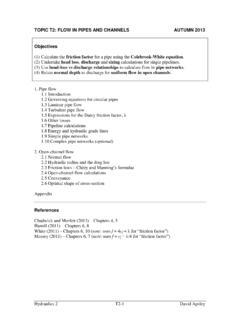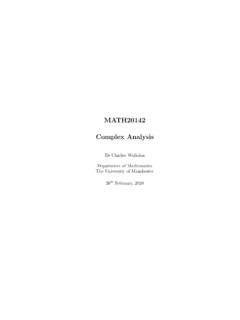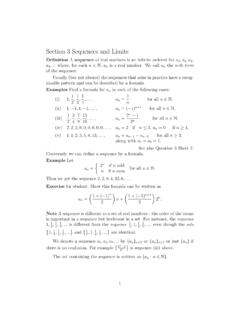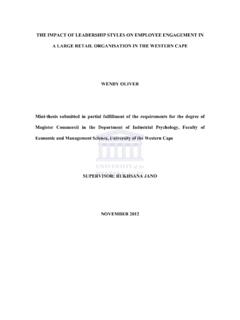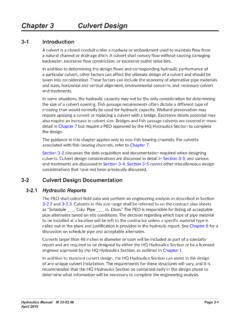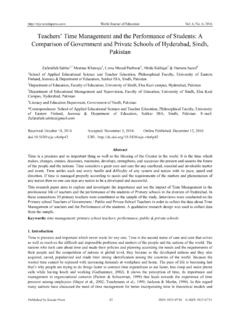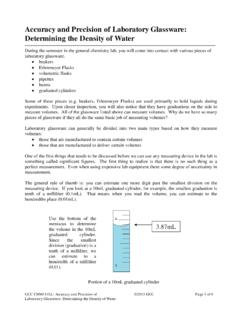Transcription of dimensions fundamental dimensions Principle of Dimensional ...
1 Hydraulics 2 T3-1 David Apsley TOPIC T3: Dimensional ANALYSIS AUTUMN 2022 Objectives (1) Be able to determine the dimensions of physical quantities in terms of fundamental dimensions . (2) Understand the Principle of Dimensional Homogeneity and its use in checking equations and reducing physical problems. (3) Be able to carry out a formal Dimensional analysis using Buckingham s Pi Theorem. (4) Understand the requirements of physical modelling and its limitations. 1. What is Dimensional analysis? 2. dimensions dimensions and units Primary dimensions dimensions of derived quantities Working out dimensions Alternative choices for primary dimensions 3. Formal procedure for Dimensional analysis Dimensional homogeneity Buckingham s Pi theorem Applications 4.
2 Physical modelling Method Incomplete similarity ( scale effects ) Froude-number scaling 5. Non- Dimensional groups in fluid mechanics References White (2011) Chapter 5 Hamill (2011) Chapter 10 Chadwick and Morfett (2013) Chapter 11 Massey (2011) Chapter 5 Hydraulics 2 T3-2 David Apsley 1. WHAT IS Dimensional ANALYSIS? Dimensional analysis is a means of simplifying a physical problem by appealing to Dimensional homogeneity to reduce the number of relevant variables. It is particularly useful for: presenting and interpreting experimental data; attacking problems not amenable to a direct theoretical solution; checking equations; establishing the relative importance of particular physical phenomena; physical modelling.
3 Example. The drag force on a sphere is a function of air speed , density , diameter and viscosity . However, instead of having to draw hundreds of graphs portraying its variation with all combinations of these parameters, Dimensional analysis tells us that the problem can be reduced to a single dimensionless relationship = (Re) where is the drag coefficient and Re is the Reynolds number. In this instance Dimensional analysis has reduced the number of relevant variables from 5 to 2 and the experimental data to a single graph of against Re. Hydraulics 2 T3-3 David Apsley 2. dimensions dimensions and Units A dimension is the type of physical quantity. A unit is a means of assigning a numerical value to that quantity.
4 SI units are preferred in scientific work. Primary dimensions In fluid mechanics the primary or fundamental dimensions , together with their SI units, are: mass M (kilogram, kg) length L (metre, m) time T (second, s) temperature (kelvin, K) In other areas of physics additional dimensions may be necessary. The complete set specified by the SI system consists of the above plus electric current I (ampere, A) luminous intensity C (candela, cd) amount of substance n (mole, mol) dimensions of Derived Quantities The dimensions of common derived mechanical quantities are given in the following table. Quantity Common Symbol(s) dimensions Geometry Area L2 Volume L3 Second moment of area L4 Kinematics Velocity LT 1 Acceleration LT 2 Angle 1 ( dimensionless) Angular velocity T 1 Quantity of flow L3T 1 Mass flow rate MT 1 Dynamics Force MLT 2 Moment, torque ML2T 2 Energy, work, heat , ML2T 2 Power ML2T 3 Pressure, stress , ML 1T 2 Fluid properties Density ML 3 Viscosity ML 1T 1 Kinematic viscosity L2T 1 Surface tension MT 2 Thermal conductivity MLT 3 1 Hydraulics 2 T3-4 David Apsley Specific heat , L2T 2 1 Bulk modulus ML 1T 2 Working Out dimensions In the following, [ ] means dimensions of.
5 Example. Use the definition = d d to determine the dimensions of viscosity. Solution. From the definition, = d /d =force/areavelocity/length Hence, [ ]=MLT 2/L2LT 1/L =ML 1T 1 Alternatively, dimensions may be deduced indirectly from any known formula involving that quantity. Example. Since Re / is known to be dimensionless, the dimensions of must be the same as those of ; [ ]=[ ][ ][ ] =(ML 3)(LT 1)(L) =ML 1T 1 Alternative Choices For Primary dimensions The choice of primary dimensions is not unique. It is not uncommon and it may sometimes be more convenient to choose force F as a primary dimension rather than mass, and have a {FLT} rather than {MLT} system. Example. Find the dimensions of viscosity in the {FLT} rather than {MLT} systems.
6 Hydraulics 2 T3-5 David Apsley Solution. From the definition, = d /d =force/areavelocity/length Hence, [ ]=F/L2LT 1/L =FL 2T Hydraulics 2 T3-6 David Apsley 3. FORMAL PROCEDURE FOR Dimensional ANALYSIS Dimensional Homogeneity The Principle of Dimensional Homogeneity All additive terms in a physical equation must have the same dimensions . Examples: = +12 2 all terms have the dimensions of length ( ) + 22 + = all terms have the dimensions of length ( ) Dimensional homogeneity is a useful tool for checking formulae. For this reason it is useful when analysing a physical problem to retain algebraic symbols for as long as possible, only substituting numbers right at the end. However, Dimensional analysis cannot determine numerical factors; it cannot distinguish between 2 and 2 in the first formula above.
7 Dimensional homogeneity is the basis of the formal Dimensional analysis that follows. Buckingham s Pi Theorem Experienced practitioners can do Dimensional analysis by inspection. However, the formal tool which they are unconsciously using is Buckingham s Pi Theorem1: Buckingham s Pi Theorem (1) If a problem involves relevant variables independent dimensions then it can be reduced to a relationship between non- Dimensional parameters 1,.., . (2) To construct these non- Dimensional groups: (i) Choose dimensionally-distinct scaling variables (aka repeating variables). (ii) For each of the remaining variables construct a non- Dimensional of the form =(variable)(scale1) (scale2) (scale3) where , , , .. are chosen so as to make each non- Dimensional .
8 Note. In order to ensure Dimensional independence in {MLT} systems it is common but not obligatory to choose the scaling variables as: a purely geometric quantity ( a length), a kinematic (time- but not mass-containing) quantity ( velocity or acceleration) and a dynamic (mass- or force-containing) quantity ( density). 1 Buckingham, E., 1914. The use of comes from its use as the mathematical symbol for a product. Hydraulics 2 T3-7 David Apsley Applications Example. Obtain an expression in non- Dimensional form for the pressure gradient in a horizontal pipe of circular cross-section. Show how this relates to the expression for frictional head loss. Solution. Step 1. Identify the relevant variables. d /d , , , , , Step 2.
9 Write down dimensions . d d [force/area]length =MLT 2 L 2L =ML 2T 2 ML 3 LT 1 L L ML 1T 1 Step 3. Establish the number of independent dimensions and non- Dimensional groups. Number of relevant variables: =6 Number of independent dimensions : =3 (M, L and T) Number of non- Dimensional groups ( s): =3 Step 4. Choose (= 3) dimensionally-independent scaling variables. geometric ( ), kinematic/time-dependent ( ), dynamic/mass-dependent ( ). Step 5. Create the s by non-dimensionalising the remaining variables: d /d , and . 1=d d Considering the dimensions of both sides: M0L0T0=(ML 2T 2)(L) (LT 1) (ML 3) =M1+ L 2+ + 3 T 2 Equate powers of primary dimensions . Since M only appears in [ ] and T only appears in [ ] it is easiest to deal with these first: M: 0=1+ = 1 T: 0= 2 = 2 L: 0= 2+ + 3 =2 +3 =1 Hence, 1=d d 1 2 1 = d d 2 (OK ratio of two pressures) can be non-dimensionalised by inspection, since it already has the same dimensions (L) as one of the scaling variables: Hydraulics 2 T3-8 David Apsley 2= Finally, 3= Considering the dimensions of both sides: M0L0T0=(ML 1T 1)(L) (LT 1) (ML 3) =M1+ L 1+ + 3 T 1 Again, as M only appears in [ ] and T only appears in [ ] then deal with these first: M: 0=1+ = 1 T: 0= 1 = 1 L.
10 0= 1+ + 3 =1 +3 = 1 Hence, 3= 1 1 1 = (OK reciprocal of Reynolds number) Step 6. Set out the non- Dimensional relationship. 1= ( 2, 3) or d d 2= ( , ) (*) Step 7. Rearrange (if required) for convenience. We may replace any by a power of that , or by a product with the other s, provided that we retain the same number of independent dimensionless groups. Here, we recognise 3 as the reciprocal of the Reynolds number, so it is more natural to use 3 =( 3) 1=Re as the third non- Dimensional group. We can also write the pressure gradient in terms of head loss: d /d = ( / ). With these two modifications the non- Dimensional relationship (*) then becomes 2= ( ,Re) or = 2 ( ,Re) Since numerical factors (here, 1/2) can be absorbed into the non-specified function, this can easily be identified with the Darcy-Weisbach equation = 22 where is a function of relative roughness / and Reynolds number Re, a function given (Topic 2) by the Colebrook-White equation.



